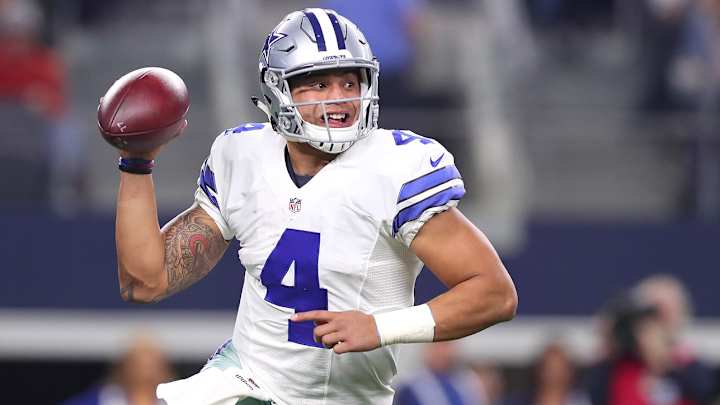Dallas Cowboys: 10 Things You Need to Know

1. Often when the public decides a team has a great offensive line, overhyping commences. Not here. Dallas’s O-line is as tremendous advertised. In fact, not only does it have the game’s best tackle (Tyron Smith), guard (Zack Martin) and center (Travis Frederick), in those men it might have the game’s three best offensive linemen period. Smith is as athletic as they come. It shows in pass protection and outside zone blocking. Martin is peerless at blocking while on the move. Frederick’s mechanics and initial quickness allow him to consistently beat defensive tackles to a spot, sealing them back inside. That’s the key to much of Dallas’s ground game.
2. It’s possible the Cowboys will have a fourth elite offensive lineman this season: third-year man La’el Collins, who is moving from left guard to right tackle. Collins is very natural at working his run-blocks up to the second level.

3. Dak Prescott had a tremendous rookie campaign, but it was played under perfect conditions. Not only did he have an O-line that provided clean pockets, he also had a true No. 1 receiver to influence coverages (Dez Bryant), two unique underneath possession targets (Cole Beasley and Jason Witten) and the NFL’s leading rusher (Ezekiel Elliott). Prescott has all of these things again in 2017, but perfect conditions in pro football never last. At some point the Cowboys will lean on Prescott to make full-field progressions reads and throws under duress. We’ll really find out about him then.
4A. Two concerns with Prescott arose down the stretch last season. One, some of the glitches in his throwing mechanics that showed up at Mississippi State reappeared. Two, he didn’t always read the field with promptness and clarity. Neither of these things are unexpected; it’s all part of a young QB’s growth process. That said, if both issues aren’t corrected, that growth process will halt early.
4B. There are two distinct positives with Prescott. One, he hasn’t come to rely on his mobility. That’s crucial for his long-term development; in the NFL, a QB must play from the pocket. This isn’t to say that Prescott’s mobility isn’t critical, though. The Cowboys make great schematic use of it, which leads to the second positive: Prescott is tremendous throwing on the move. That has given Dallas a potent play-action rollout game, allowing them to throw on early downs and force backside defenders to line up cautiously wide, which helps your inside runs.
Eight Important Questions Regarding Ezekiel Elliott's Suspension Appeal
5. Given how their skills complement each other, there isn’t a better possession receiver tandem than Witten and Beasley. Witten is great at uncovering over the middle. He’s a safety blanket late in the down, which is important when you have an O-line that can hold up in pass pro for so long and a young QB who is still learning to read the field. Beasley is almost the opposite: He gets himself open early in the down. His quickness and deceptiveness coming off the line is tantamount to Dallas’s success in the empty spread formations that Prescott likes.
6. Defensive coordinator Rod Marinelli remains a Cover 2 subscriber, but that isn’t to say this is a vanilla scheme. The Cowboys diversify their coverages just enough to avoid having tendencies. They don’t blitz often, but when they do it’s almost always out of a front with a defender aligned directly over the center. Also, it almost always involves some sort of gap exchange, with defenders starting in one gap but attacking another. That’s also a big component of their regular four-man rush.
7. When you run as many D-line slants as the Cowboys do, it’s imperative that your linebackers have the speed, awareness and mechanical efficiency to scrape outside and cover the area away from the slant. Sean Lee is great here. Dallas’s other linebackers—Damien Wilson and Jaylon Smith—are physically capable, as well.
8. A lot rides on first-round rookie Taco Charlton. This pass rush was impotent for much of last season. It badly needs a speed presence off the edge.
The Cowboys’ (Draft) Class Is Showing
9. It’s a shame that 2016 sixth-round cornerback Anthony Brown had some coverage gaffes on grand stages like Thanksgiving Day and Sunday Night Football. That misrepresented what was otherwise a tremendous season. Brown thrived in the slot and outside, where he showed a great sense for forcing vertical receivers into the sideline. With second-round rookie Chidobe Awuzie and third-rounder Jourdan Lewis now aboard, plus ex-Eagle Nolan Carroll signing in free agency, Brown will have to shine again just to get on the field. The guess here is that he will.
10. Let’s hope the Cowboys don’t just plop Byron Jones at free safety and call it a day. With so many of their defensive backs being versatile, they shouldn’t have to. Most versatile amongst those DBs, of course, is Jones himself. He can match up on tights end and certain slot receivers. The Cowboys need to find a second free safety with range, so that Jones can slide down and handle these coverage responsibilities in obvious passing situations.
• Question or comment? Email us at talkback@themmqb.com.
